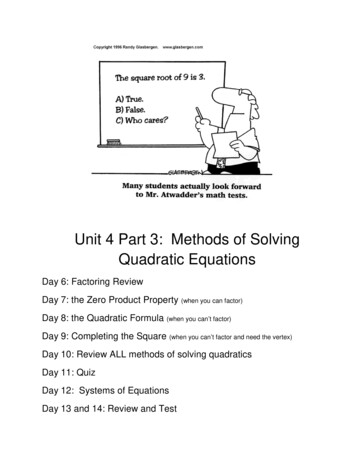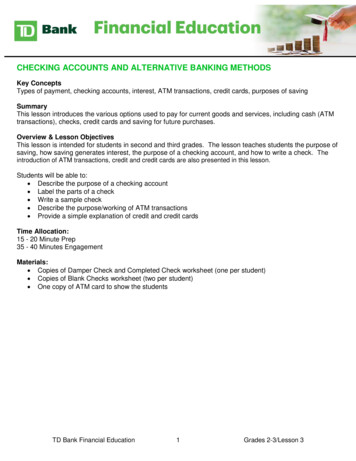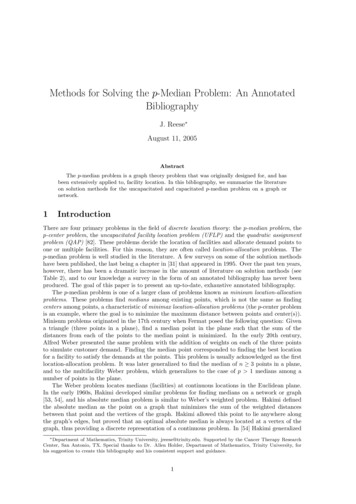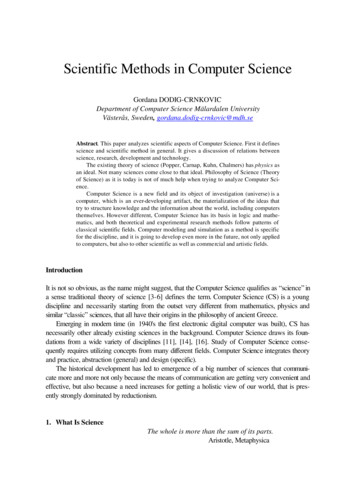
Transcription
Unit 4 Part 3: Methods of SolvingQuadratic EquationsDay 6: Factoring ReviewDay 7: the Zero Product Property (when you can factor)Day 8: the Quadratic Formula (when you can’t factor)Day 9: Completing the Square (when you can’t factor and need the vertex)Day 10: Review ALL methods of solving quadraticsDay 11: QuizDay 12: Systems of EquationsDay 13 and 14: Review and Test
Algebra2 Notes: Factoring ReviewWe will:I will:Discuss: What do we know about the QUADRATIC function family?yHow did we find key parts of a Quadratic?1. Vertex321x 3 2 112345 12. Y-intercept 2 33. Increasing and decreasing intervals 44. End behavior5. Zero’s (solutions, roots, x-intercepts)WHY FACTOR quadratics? To find the zero’s analytically (Convert standard to vertex form)1.Factoring quadratic TRINOMIAL with leading coefficient of 1 (a 1)QuadraticTermx 2 bx cConstantLinear TermSteps to factoring:T1. Decide the signs for the parentheses based on the CONSTANT TERM.c is positivesame signsc is negative2.3.4.different signsFind 2 #’s that MULTIPLY to the constant term and ADD to the linear termWrite as two binomials. (note: The LARGER # from step 2 should go with the sign ofthe linear term.)Check your answer (FOIL)6
2. s 2 5s 361. x 2 14 x 322.A SPECIAL TRINOMIAL - Perfect Square Trinomials:1. x2 – 16x 64 We can summarize this pattern:a2 2ab b2 (a b)(a b) (a b)2a2 - 2ab b2 (a - b)(a - b) (a - b)22. x2 10x 25 3. x2 24x 144 4. x2 – 14x 49 5. 4x2 12x 9 A quick hint for this pattern:3.A SPECIAL BINOMIAL - Difference of two squares:1. x2 – 25 x2 0x – 25 We can summarize this pattern:a2 – b2 :2. x2 – 9 (a b)(a – b)3. 49x2 – 121 4. x2 100
What if the leading coefficient is NOT 1? Or we ALMOST have the difference of twosquares?4. Factoring out a Greatest Common Factor1.2.5x2 – 1252. -4x2 196x4 13x3 30x24. 3x2 18x - 48What if we don’t have a GCF and we’re stuck with a coefficient 1?5.Factoring quadratic TRINOMIAL with leading coefficient 1LeadingCoefficientAx 2 Bx CQuadraticTermLinearTermConstantrmThe leading coefficient is .Method 1: Guess and Check1.2x2 5x 3
Method 2: GroupingSteps for factoring trinomials by grouping1. Decide your signs for the parentheses. Suggestion – put your negative first.2. Multiply A C3. Find 2 #’s that multiply to equal A C and add to the linear term (B).4. Rewrite Bx as a sum of the two factors. There will be 4 terms.5. Factor by grouping:Group the first two terms and the last two termsFactor the GCF out of each group {the parentheses should match}Use distributive property to write as two binomials6. Check your answer - FOIL!!!1.2x2 5x 3Method 3: Slide/Divide/BOTTOMS UP!1. Multiply A C (This is your SLIDE)2. Factor like a trinomial with coefficient of 1 (BUT YOUR’RE NOT DONE!)3. Divide constants in your binomials by A. (This is your DIVIDE – BUT YOU’RE NOT DONE!)4. Simplify your new ratios.5. If denominators remain, multiply the variable by this constant and get rid of your denominator.(This is your BOTTOMS UP – and NOW you’re done.)6. Check your answer - FOIL!!!1.2x2 5x 3
1: Factor 2 x 7 x 6222: Factor 6 y 13 y 53.15 x 2 13 x 24.12a 2 31a 75.7 y 2 18 y 86.9 x 2 12 x 5
7.6 x2 5x 48.3 x 2 18 x 15Thoughts on PATTERNS:1. x4 – 252. (x 1)2 – 43. x6 – y44. 4x4 – 4x2 1
Algebra2 Notes: Using the Zero Product PropertyI will:We will:Key Ideas About SOLUTIONS to Quadratic Equations Quadratics can have 1, 2, or 0 REAL solutions.The REAL solution is the x-coordinate where the parabola crosses the x-axis.The y-coordinate of ANY point on the x-axis is 0, so .to find solutions, we set our quadratic 0.We've solved quadratics using the SQUARE ROOT METHOD 10 y1. x2 – 10 08642 10 8 6 4 2 2x246810 4 6 8 102. Solve the equation(x – 6)2 4(Why can you use the square root method on this?)10 y8642 10 8 6 4 2 2x2 4 6 8 10BUT WHAT IF . we are stuck with an x term?We must solve the quadraticBY FACTORING and USING THE ZERO PRODUCT PROPERTY46810
Zero Product Property:If the product of two expressions is zero thenone or both of the expressions is zero.If A·B 0, then either A 0 or B 0We can apply this concept to quadratic equations to find the solutions:x2 – 6x – 5 0IfNotice that the(x – 1)(x – 5) 0FACTORS and the SOLUTIONSswitch signs!Then either (x – 1) 0 or (x – 5) 0Therefore x or x (Graph this to check the intercepts)10 y81.Solve the quadratic equationx2 – 6x 06(Discuss: How is this different from our example?)42 10 8 6 4 2 2x246810 4 6 8 1010 y2. Solve the quadratic equation8x2 – 4x 45642 10 8 6 4 2 2x246810 4 6 8 10TURN&TALK: How is using the Zero Product Property to solve a quadratic equation related to theintercept form of a quadratic function?3.Find the solutions of2x2 - 11x 12 0
4. Find the solutions to the quadratic equation5. Find the x-intercepts of6. Solve the equation–4x2 – 8x – 3 3 – 5x2f(x) –2x2 – 14x – 10 (What must you do first?)6x2 – 13x 3 –3
Algebra 2 Notes – The Quadratic FormulaI will:We will:Part 1: The Discriminant –How can we tell quickly whether a quadratic has 0, 1, or 2 real solutions? Is there ananalytic way to determine this?1. f(x) x2 – 2x2. f(x) –x2 2x2y4132 2 111 3 2234 1 12134 2 1 3 2a b c a b c Now calculate: (b)2 – 4(a)(c) Now calculate: (b)2 – 4(a)(c) ** Discuss: Why are the parentheses important?3. f(x) –x2 2x - 14. F(x) x2 – 2x 221y4 3 2 11233 12 21 3 4 3 2 11234 1a b c a b c Now calculate: (b)2 – 4(a)(c) Now calculate: (b)2 – 4(a)(c) Discuss: What are your observations?
The DISCRIMINANT(b)2 – 4(a)(c) : ifDISCRIMINANT 0, thenDISCRIMINANT 0, thenDISCRIMINANT 0, thenWhy do I even need that if I can use my calculator?Try this one -- How many real solutions fory x2 2x – 143 ?Where does this come from?Part 2: The Quadratic FormulaWhat this looks like .10 y86y ax2 bx c42vertex: 10 8 6 4 2 2 4 6 8 10x246810
1.Describe the nature of the solution set and determine the solutions to:x2 – 5x 4Get this ready:Can this be factored?a. DESCRIBE the nature of the solutions (or solution set)a b c Discriminant: (b)2 – 4(a)(c) b. SOLVE the quadraticUse the quadratic formula: x 2.Describe the nature of the solution set and determine the solutions to:4x2 10x -10x - 25Get this ready:Can this be factored?a. DESCRIBE the solutions (or solution set)a b c b. SOLVE the quadraticUse the quadratic formula: x Discriminant: (b)2 – 4(a)(c)
3.Describe the nature of the solution set and determine the solutions to:x2 - 6x -10Get this ready:Can this be factored?a. DESCRIBE the solutions (or solution set)a b c Discriminant: (b)2 – 4(a)(c) b. SOLVE the quadraticUse the quadratic formula: x -------------------How about these? Can you SOLVE these quadratics? Discuss: Could you use factoring?1. x2 2x 1 02. 2x2 4x – 1 03. 3x2 – 4x -5
Algebra 2 Notes – Completing the SquareWe will:I will:We’ve been having FUN with quadratics – SOLVING them, & GRAPHING them.y x2 – x - 121. Solve10 y8642 10 8 6 4 2 2x246810 4y x2 – x - 12Graph 6 8 102. Solvey (x – 2)(x 2)10 y8642Graphy (x – 2)(x 2) 10 8 6 4 2 2x246810 4 6 8 103.y x2 10x 2510 y8Solve it:642Graph it: 10 8 6 4 2 2 4 6 8 10x246810
2. y x2 – 2x 110 y864Solve it:2 10 8 6 4 2 2x246810 4 6 8 10Dealing with perfect square trinomials is NICE!!!!! Our next method takes advantage ofthis and FORCES quadratics into being a perfect square trinomial.Background for Completing the Square – Making a perfect square trinomial2 b 2Trinomial ax bx cConstant term (or c) 2 Fill in c to make these quadratics a perfect square trinomialy x2 – 4x cy x2 4x cy x2 – 6x cy x2 6x cy x2 – 8x cy x2 8x cSteps to Solving Quadratics by COMPLETING THE SQUARE1.2.3.4.5.Move constant to one side of the equationCalculate the “c” needed to complete the squareAdd this value to BOTH sidesRewrite your trinomial as a perfect squareUse the square root method to solve the equation
x2 – 10x 1 01.10 y8642 10 8 6 4 2 2x246810 4 6 8 10TURN&TALK: How is completing the square related to the vertex form of a quadratic?10 y82.x26– 10x –2242 10 8 6 4 2 2x246810 4 6 8 10SOLVE this quadratic by completing the square. Note – COULD we factor these?3. x2 – 12x 4 04. x2 – 4x 8 0 (Discuss: Will this parabola cross the x-axis? Why?)
5. x2 6x 4 0Discuss: Why would you use the method of . Give an example of a quadratic for each method.1. FACTORING2. SQUARE ROOT METHOD3. COMPLETING THE SQUARESolve by Completing the Square when a 13x2 – 36x 150 0Divide each side (every term) by the coefficient of x2YOU TRY. Solve by completing the square.1. 2x2 8x 14 0Discuss: What is your favorite method of solving a quadratic and WHY?
Solving Quadratics Review – Putting It All TogetherFactor completely.1.9x 2 252.x 2 2x 153.3x 2 5x 124.9x 2 30x 255.8x 2 186.5x 2 30x 457. Name 3 synonyms for “solution”: , ,Our QUADRATIC TOOLBOXWe know 4 ways to solve quadratic equations. List them. Explain each technique and WHENyou would use it.1.2.3.4.
Using the QUADRATIC TOOLBOXSolve the following using TWO techniques. Specify each one & explain why you chose it.1.x2 – 7x 12 02.x2 1 - xMethod 1:Reason:Method 1:Reason:Work:Work:Method 2:Reason:Method 2:Reason:Work:Work:3.x2 3x 154.x2 8x – 13 0Method 1:Reason:Method 1:Reason:Work:Work:Method 2:Reason:Method 2:Reason:Work:Work:
x2 – 2x – 8 0For the quadraticSolve by the Zero ProductProperty (Factoring)Solve by Completing the Squarex2 – 2x – 8 0x2 – 2x – 8 0Solve Using the QuadraticFormulax2 – 2x – 8 0Solutions:Solutions:Rewrite to Intercept Formy x2 – 2x – 8Solutions:Rewrite to Vertex Formy x2 – 2x – 8Describe the RootFind the Discriminant:Intercept form:Vertex Form:Identify the Number and Type ofSolutions:Identify the x-intercepts(,) and (,Identify the Vertex:)Given y x2 – 2x – 8Graph: y x2 – 2x – 810 y86Find the Vertex:42Axis of symmetry: 10 8 6 4 2 2 4Direction: 6 8 10Size (Vertical Stretch, VerticalShrink or Standard):x246810
Algebra 2 Notes – Solving SYSTEMS of EquationsWe will:I will:When solving systems of equations where one equation is a quadratic,we can have one, two, or no solutions.One SolutionTwo SolutionNo SolutionThe easiest way to solve a system of equations will always be graphing.When graphing, the solutions to a system of equations are the points of intersection!1.2.
Graph the following systems of equations. The solution is the set of all ordered pairsthat intersect each function.Ask yourself what KINDS of functions you have in your system .1.y 4 2 x 5y 2.y x 1 1 y x2 110 y10 y8866442 10 8 6 4 2 22x246810 10 8 6 4 2x2 2 4 4 6 6 8 8 10 1046We can also solve systems algebraically by substitution.Steps:1.2.3.4.Solve one of the equations for a variable.Substitute the expression into the other equation.Solve the equation.Substitute the value found into one of the equations and solve for the remainingvariable.10 y5. Name the point (x, y).81.6y x2 6x 14y -2x – 142 10 8 6 4 2 2x246810 4 6 8 102. y –(x – 2)2 3y 2x8642 8 6 4 2 2 4 6 82468810
83. y x26- 2x 1y 3-x42 8 6 4 2 2242468 4 6 84. y x2 - 2x - 18y - x2 4x - 1642 8 6 4 2 2 4 6 868
Algebra2 Quadratics Test ReviewGraph without a calculator.1. y x2 2x – 3XY10 y8Form:64Vertex:2Axis of symmetry: 10 8 6 4 2 2x246810 4Direction: 6 8Dilation or Standard: 10Solutions:2. y - (x 1)(x – 5)Form:10 yX8Y64Vertex:2 10 8 6 4 2Axis of symmetry: 2x246810 4Direction: 6 8Dilation or Standard: 10Solutions:3. y (x – 2)2 3XY10 y8Form:64Vertex:Axis of symmetry:Direction:Dilation or Standard:Solutions:2 10 8 6 4 2 2 4 6 8 10x246810
y 2 ( x 3)4. 210 yXY8Form:6Vertex:24 10 8 6 4 2Axis of symmetry: 4 6Direction: 8Dilation or Standard: 10Solutions:“Technology Enhanced” SOL-like Questions1. Circle the zero/s or root/s.y4321x 2 2 112345 1 22. Circle all zeros/roots of the equation.x 1/3x -5x 5(3x – 1)(x 5) 0x -1/3x -33. Given 2x2 – x – 6, circle its factors.(x 2)(2x – 3)(2x 3)(x – 2)(x – 3)4. Given 3x2 6x, circle its factors.(3)(x)(3x)(x 6)(x – 2)(x 2)5. Identify the function/s with the same range as y (x – 1)2 5.y x2 5y -x2 5y x2 2x 5y x2 – 5y (x – 1)2x246810
6. Given the zeros: x -1, x 4, identify the function.y x2 - 3x – 4y (x – 1)(x 4)y x2 – 3x 4y x2 3x – 4y (x 1)(x – 4)y -x2 3x 47. Which of the following expressions have a factor of (x 7)?x2 49x2 5x - 14x2 - 492x2 15x 72x2 14x8. Describe the nature of the roots.62 real roots541 real root32 imaginary roots21 2 1no real root123 1From this graph, what can you tell about the discriminant?Factor (Hint: Remember to look for a GCF first. None of these are prime.):1. 3x2 - 752. x2 - 2x - 483 4a2b2 – 9a2b24. 2x2 6x - 805. 15x2 7x - 26. 11x2 - 19x - 6
Solve the following using the method of your choice. Check your answer with a graphing calculator:7.9.w2 16 w 48 021r 2 14r 0Given the quadratic equationSolve by the Zero Product Property(Factoring)28.x - 6x 8 010.c 2 121 02 x 2 4 x 8 x 2 xx2 - 6x 8 0Solve by Completing the Square2x - 6x 8 0Solve Using the Quadratic Formulax2 - 6x 8 0
Rewrite to Intercept Formy x2 - 6x 8Describe the RootIdentify the Number and Type ofSolutions:Find the Discriminant:Identify the x-intercepts( , )and( , )Given y x2 - 6x 8Graph y x2 - 6x 810 y8Find the Vertex:642 10 8 6 4 2 2 4 6 8Axis of symmetry:Direction:Size: 10x246810
Steps for factoring trinomials by grouping 1. Decide your signs for the parentheses. Suggestion – put your negative first. 2. Multiply A C 3. Find 2 #’s that multiply to equal A C and addto the linear term (B). 4.











